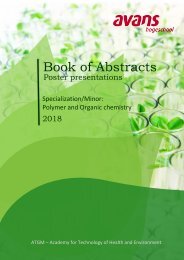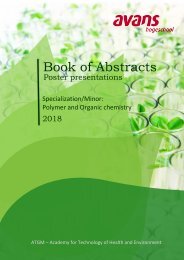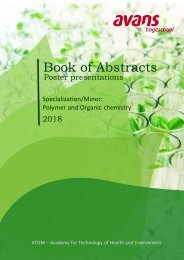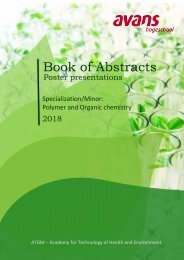Book of abstracts version 5
Create successful ePaper yourself
Turn your PDF publications into a flip-book with our unique Google optimized e-Paper software.
The inhibition <strong>of</strong> the Pseudomonas Aeruginosa bacteria<br />
Author<br />
Mariët Bakker<br />
Academy <strong>of</strong> Technology for Health and Environment<br />
Avans Hogeschool, Breda<br />
Universiteit Utrecht<br />
Nishant Sewgobind<br />
Abstract<br />
The bacterial adhesion lectin LecA is an attractive target for the interference with the infectivity <strong>of</strong> its producer<br />
Pseudomonas Aeruginosa.[1] Divalent ligands with two terminal galactoside moieties were shown to be potent inhibitors.<br />
In hopes <strong>of</strong> further enhancing the LecA inhibitory, a divalent galactoside ligand will be expanded to a quadrupole<br />
galactoside ligand, as shown in Figure 1. The linking between two divalent galactosides takes place through a PEG -<br />
coupling molecule (8). [2]<br />
In this research, the starting material for synthesizing the PEG-molecule is 1,4-dimethoxybenzene(2). The synthesis route<br />
is shown in Figure 2. The first step is the halogenation <strong>of</strong> 1,4 -dimethoxybenzene(2). After the synthesis <strong>of</strong> 2,5-diiodo-1,4-<br />
dimethoxybenzene(4), the product has reacted with a [TMAH][Al 2Cl 7] complex to replace a methoxide group for a<br />
hydroxyl group. The third step is the synthesis <strong>of</strong> ditosyl tetraethylenegycol( 7), which can react with the demethylated<br />
phenol(4) to form the PEG coupling molecule called 2,5-diiodo-4-methoxyphenol. The reactions were followed with TLC<br />
and the products were analyzed by FTIR and HNMR.<br />
Keywords: LecA, Pseudomonas Aeruginosa, PEG, halogenation, demethylation<br />
Table <strong>of</strong> content<br />
Figure 1: Two divalent galactosides are coupled by a PEG. Figure 2: The synthesis routes in this research.<br />
[1] Novoa, Alexandre. Eierh<strong>of</strong>f, Thorsten. Topin, Jérémie. “A LecA Ligand Identified from a Galactoside-Conjugate Array<br />
Inhibits Host Cell Invasion by Pseudomonas aeruginosa”. Angewandte Chemie. (2014)<br />
[2] Bouvier, Benjamin. “Optimizing the multivalent binding <strong>of</strong> bacterial Lectin LecA by glycopeptide dendrimers for<br />
therapeutic purposes”. Journal <strong>of</strong> Chemical information and modelling, ACS publications (2016)<br />
13









